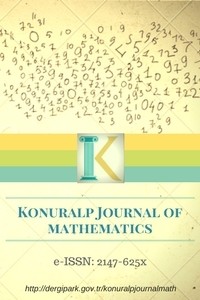Characteristic Directions of Closed Planar Homothetic Inverse Motions
___
- [1] Blaschke W., M\"{u}ller H.R., \text{Ebene Kinematik}, R. Oldenbourg, M\"{u}nchen, (1956).
- [2] Dathe H., Gezzi R., Characteristic directions of closed planar motions, \text{Zeitschrift f\"{u}r Angewandte Mathematik und Mechanik}, \text{92} (2012), 731-748.
- [3] Kuruo\u{g}lu N., D\"{u}ld\"{u}l M., Tutar A., Generalization of Steiner formula for the homothetic motions on the planar kinematics, \text{Applied Mathematics and Mechanics (English Edition)},\text{24} (2003), 945-949. }
- [4] M\"{u}ller H.R., Verall gemeinerung einer Formel von Steiner, \text{Abh. Braunschweig. Wiss. Ges.}, \text{29} (1978), 107-113. }
- [5] M\"{u}ller H.R., \"{U}ber Tr\"{a}gheitsmomente bei Steinerscher Massenbelegung, \text{Abh. Braunschweig. Wiss. Ges.}, \text{29} (1978), 115-119. }
- [6] Steiner J., Von dem Kr\"{u}mmungs-Schwerpuncteebener Curven, \text{Journal f\"{u}r die reine und angewandte Mathematik}, \text{21} (1840), 33-63.}
- [7] T\"{o}lke J. Steiner-Formein f\"{u}r die Bahnflachen geschlossener Aquiaffinbewegungen, \text{Sitzungsber \"{O}sterr. Akad. Wiss, Math.-Nat. Klasse}, \text{187} (1978), 325-337. }
- [8] Tutar A., Kuruo\u{g}lu N., The Steiner formula and the Holditch theorem for the homothetic motions on the planar kinematics, \text{Mechanism and Machine Theory}, \text{34} (1999), 1-6.}
- Yayın Aralığı: Yılda 2 Sayı
- Başlangıç: 2013
- Yayıncı: Mehmet Zeki SARIKAYA
Sevtap SÜMER EKER, Bilal ŞEKER
Nesrin Çalışkan, Ayşe Funda SAĞLAMER
Ayhan TUTAR, Önder ŞENER, Esra İNAN
İbrahim İlker AKÇA, Yavuz SİDAL
Sibel Yalçın, Kaliappan Vijaya, Gangadharan Murugusundaramoorthy
Slim BOUAZİZ, Kamel MEZLİNİ, Ahmed FİTOUHİ
